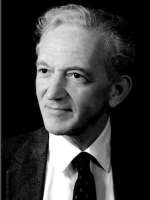Peter Safar

Peter Josef Safar (1924-2003) was an Austrian physician, innovator, educator and humanist.
Peter Safar was a pioneer of cardiopulmonary resuscitation and critical care medicine a relentless interest in everything and was a true humanist.
Born in Austria of Jewish ancestry he managed to evade the Nazis as a young man and survived the tragic death of his young daughter from status asthmaticus. Despite such terrible trials he went on to give the world ‘the kiss of life‘ and became the acknowledged ‘Father of modern CPR’ and devised the first 15-step protocol for Rapid Induction/Intubation (RSI).
Biography
- Born on April 12, 1924
- 1976 – Co-founded the World Association for Disaster and Emergency Medicine (WADEM)
- Professor of resuscitation medicine University of Pittsburgh
- Died on August 3, 2003
CPCR is for the person with a heart and brain too good to die.
Medical Eponyms
Peter’s Laws for the Navigation of Life (1994)
In 1994, on the occasion of his 70th birthday Safar was presented with a framed set of laws by his friends and colleagues. These laws were derived from the sayings of Peter Safar himself. They were titled ‘Peter’s Laws for the Navigation of Life‘ with the instructive subtitle ‘The Creed of the Sociopathic Obsessive Compulsive‘.
Rapid Sequence Induction (RSI) in 1970
A fifteen-step method of induction and intubation for avoiding aspiration of gastric contents, which has been used successfully in 80 patients over a 2-year period, is described.
Sept, Safar 1970
- Start intravenous infusion.
- Check equipment, including tracheal tube, cuff, stylet (for control of tube in emergency to avoid risking failure with the first attempt at intubation), adapters, oxygen source, bag-mask, and suction turned on, with a large-bore, rigid pharyngeal suction tip near the patient’s head.
- Insert a large-bore nasogastric tube and decompress the stomach with intermittent strong suction, to correct abdominal distention.
- Clean mouth and pharynx of foreign material, including dentures.
- Denitrogenate the lungs with 100 percent oxygen for at least 2 minutes, using a nonrebreathing system or a semiclosed-circuit system with over 10 L./min. flow and tight mask fit. Continue oxygen inhalation until intubation.
- Place patient in semisitting, V-position, with trunk elevated about 30 degrees, to counteract regurgitation by gravity, and feet elevated to prevent postural hypotension. Place pillow under occiput to support the head in the “sniffing” position for intubation.
- Apply electrocardiographic electrodes for monitoring the heart.
- Inject d-tubocurarine (3 mg/70 kg. body weight) intravenously.
- Give a predetermined dose of thiopental (e.g. 150 mg/70 kg. body weight) intravenously, about 2 minutes after injection of d-tubocurarine.
- Tilt the patient’s head gently backward with the onset of unconsciousness, and have an assistant apply and maintain firm, continuous cricoid pressure to close the oesophagus until the tracheal tube cuff is inflated at step 13.
- Inject succinylcholine chloride intravenously 100 mg/70 kg. body weight, immediately after the thiopental or the onset of unconsciousness
- Allow respiration to cease spontaneously. Apnea is essential, since partial paralysis would result in straining and regurgitation.
- Remove the mask while sustaining cricoid pressure, expose the larynx, and intubate the trachea rapidly; then inflate the cuff.
- Release cricoid pressure; ventilate; switch to maintenance anaesthetic.
- Insert a gastric tube, if one is not already in place.
Controversies
In 1966, while Safar was away at a medical conference, his 11 year old daughter Elizabeth fell into an asthma induced coma and died. Safar became convinced that lay people, not just doctors, had to be involved in resuscitation if lives were to be saved. One year after his daughter’s death he designed and implemented the first ambulance service with a physician and volunteers trained in CPR.
On his 70th birthday Safar was presented with a framed set of laws by his friends and colleagues derived from his won sayings. They were titled ‘Peter’s Laws for the Navigation of Life – The Creed of the Sociopathic Obsessive Compulsive‘.
Major Publications
- Safar P. Mouth-to-mouth airway. Anesthesiology. 1957 Nov-Dec;18(6):904-6.
- Safar P, Escarraga L, Elam J. A comparison of the mouth-to-mouth and mouth-to-airway methods of artificial respiration with the chest-pressure arm-lift methods. N Engl J Med. 1958 Apr 3;258(14):671-7.
- Safar P. Ventilatory efficacy of mouth-to-mouth artificial respiration; airway obstruction during manual and mouth-to-mouth artificial respiration. J Am Med Assoc. 1958 May 17;167(3):335-41.
- Safar P, McMahon MC. Resuscitation of the unconscious victim: a manual for rescue breathing. CC Thomas. 1959.
- Safar P, Redding J. The “tight jaw” in resuscitation. Anesthesiology. 1959 Sep-Oct;20:701-2.
- Stept WJ, Safar P. Rapid induction-intubation for prevention of gastric-content aspiration. Anesth Analg. 1970 Jul-Aug;49(4):633-6. [Original RSI paper]
- Safar P, Grenvik A. Organization and physician education in critical care medicine. Anesthesiology. 1977 Aug;47(2):82-95.
- Safar P. Cardiopulmonary Cerebral Resuscitation. AS Laerdal. 1981
References
Biography
- Lenzer J. Peter Josef Safar. BMJ. 2003 Sep 13;327(7415):624
- Mitka M. Peter J. Safar, MD: “father of CPR,” innovator, teacher, humanist. JAMA. 2003 May 21;289(19):2485-6
- Stoy W, Grandey JT. Teacher, clinician … friend. Tributes to Peter Safar. JEMS. 2003 Oct;28(10):20-4.
- Acierno LJ, Worrell LT. Peter Safar: father of modern cardiopulmonary resuscitation. Clin Cardiol. 2007 Jan;30(1):52-4.
Eponym
- Baskett PJ. Peter J. Safar, the early years 1924-1961, the birth of CPR. Resuscitation. 2001 Jul;50(1):17-22.
- Baskett PJ. Peter J. Safar. Part two. The University of Pittsburgh to the Safar Centre for Resuscitation Research 1961-2002. Resuscitation. 2002 Oct;55(1):3-7.
- Martens P, Mullie A. (Some of the) lessons learned from Peter Safar. Eur J Emerg Med. 2003 Dec;10(4):257.
- Delooz H. International emergency medicine: the vision of a pioneer, Prof. Dr Peter Safar, on emergency medical care. Eur J Emerg Med. 2003 Sep;10(3):163
Eponym
the person behind the name
Dr Tom Cassidy MBBS FACEM. Emergency physician, Perth Australia. Father of two humans and whimsical lyricist. Special skills: relocating ECGs, reading toxidromes and interpreting dislocations | @tgpcassidy | LinkedIn |
